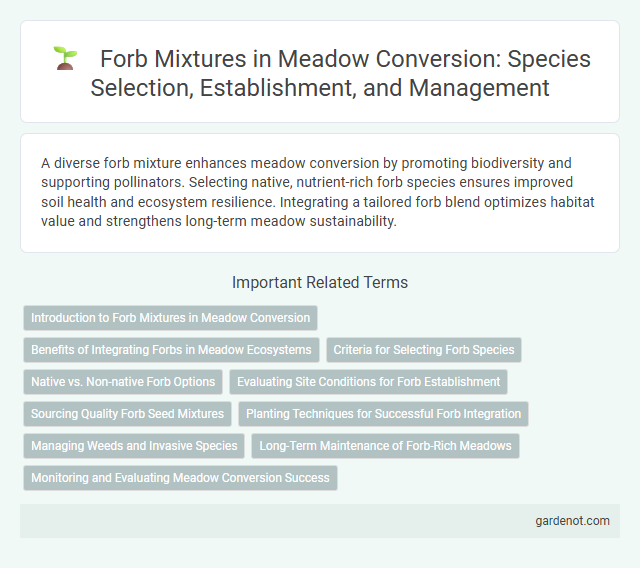A diverse forb mixture enhances meadow conversion by promoting biodiversity and supporting pollinators. Selecting native, nutrient-rich forb species ensures improved soil health and ecosystem resilience. Integrating a tailored forb blend optimizes habitat value and strengthens long-term meadow sustainability.
Introduction to Forb Mixtures in Meadow Conversion
Forb mixtures play a crucial role in meadow conversion by enhancing plant biodiversity and improving habitat quality for pollinators and wildlife. These mixtures typically include native wildflowers and broadleaf herbaceous plants, selected for their adaptability to local soil and climate conditions. Incorporating well-balanced forb mixtures increases ecosystem resilience, supports nutrient cycling, and promotes long-term sustainability of converted meadow landscapes.
Benefits of Integrating Forbs in Meadow Ecosystems
Integrating forb mixtures into meadow ecosystems enhances biodiversity by providing diverse nectar and pollen sources that attract pollinators such as bees, butterflies, and other beneficial insects. Forbs improve soil health through their deep root systems, which increase soil aeration and nutrient cycling, fostering greater ecosystem resilience. These plant species also offer habitat and food for various wildlife, contributing to balanced and sustainable meadow environments.
Criteria for Selecting Forb Species
Criteria for selecting forb species in meadow conversion emphasize adaptability to local soil conditions, climate resilience, and ecological compatibility with native flora and fauna. Forbs should exhibit high biodiversity benefits, including support for pollinators and other wildlife, while maintaining growth patterns that ensure sustainable ground cover and competition management. Seed provenance, germination rates, and potential allelopathic effects are critical factors to optimize establishment success and long-term meadow stability.
Native vs. Non-native Forb Options
Native forb options in meadow conversions promote local biodiversity by supporting indigenous pollinators and wildlife adapted to specific ecosystems. Non-native forb species, while sometimes offering rapid ground cover and aesthetic value, can outcompete native flora, potentially disrupting ecological balance. Selecting a diverse mix of native forbs tailored to regional soil and climate conditions enhances meadow resilience and long-term habitat quality.
Evaluating Site Conditions for Forb Establishment
Evaluating site conditions for forb establishment requires assessing soil pH, nutrient levels, and moisture availability to ensure optimal growth. Forb species thrive in well-drained soils with moderate fertility, where competition from aggressive grasses is minimal. Understanding light exposure and existing vegetation helps select a forb mixture that enhances biodiversity and supports pollinator habitats.
Sourcing Quality Forb Seed Mixtures
Sourcing quality forb seed mixtures is essential for successful meadow conversion, ensuring a diverse and resilient plant community that supports pollinators and enhances ecosystem services. High-purity seeds from reputable suppliers guarantee genetic diversity and optimal germination rates, crucial for establishing competitive forb populations. Selecting regionally adapted forb species further improves establishment success and long-term meadow sustainability.
Planting Techniques for Successful Forb Integration
Successful forb integration in meadow conversion requires selecting a diverse forb mixture tailored to local soil and climate conditions. Seedbed preparation involves creating a firm, fine-textured soil surface to enhance seed-to-soil contact essential for forb germination. Techniques such as shallow broadcasting followed by light rolling improve even distribution and establishment of forbs within the meadow ecosystem.
Managing Weeds and Invasive Species
A carefully selected forb mixture enhances biodiversity while effectively managing weeds and invasive species by outcompeting them for resources. Incorporating native forbs tailored to local ecology suppresses invasive growth through rapid establishment and dense coverage. Strategic mowing and monitoring during early growth stages ensure dominant forbs thrive, minimizing weed encroachment.
Long-Term Maintenance of Forb-Rich Meadows
Maintaining forb-rich meadows long-term requires regular adaptive management practices, including periodic mowing or targeted grazing to control encroaching grasses and woody species. Applying seed mixes with native, site-specific forbs enhances biodiversity and resilience, ensuring sustained flowering and pollinator support. Monitoring soil health and moisture levels supports optimal forb growth, promoting ecological stability over time.
Monitoring and Evaluating Meadow Conversion Success
Monitoring and evaluating forb mixture in meadow conversion involves assessing species diversity, coverage, and growth rates to ensure ecological balance. Regular sampling and photographic documentation track changes in forb population and identify invasive species threats. Employing metrics such as forb density and flowering frequency provides quantitative data essential for adaptive management strategies.
Forb mixture Infographic

 gardenot.com
gardenot.com